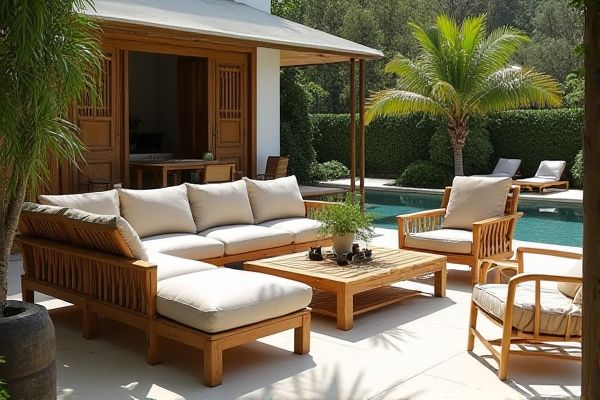
Bamboo outdoor furniture offers a lightweight, eco-friendly option with natural resistance to moisture and insects, while teak furniture is renowned for its durability, rich color, and ability to withstand harsh weather conditions over time. Explore the rest of the article to discover which material best suits Your outdoor living space needs.
Table of Comparison
| Feature | Bamboo Outdoor Furniture | Teak Outdoor Furniture |
|---|---|---|
| Material | Fast-growing bamboo grass | Dense hardwood from Tectona grandis tree |
| Durability | Moderately durable; prone to weathering without treatment | Highly durable; naturally resistant to rot and insects |
| Maintenance | Requires sealing and regular upkeep | Low maintenance; occasional oiling recommended |
| Weather Resistance | Less resistant; can warp or crack in extreme conditions | Excellent resistance to rain, sun, and humidity |
| Weight | Lightweight and easy to move | Heavier and more solid |
| Eco-Friendliness | Highly sustainable; fast renewable resource | Moderately sustainable; slower growth rate |
| Cost | Generally more affordable | Premium price due to hardwood quality |
| Aesthetic | Natural, modern, and light appearance | Classic, rich golden-brown patina |
Introduction: Bamboo vs Teak Outdoor Furniture
Bamboo outdoor furniture offers a lightweight, eco-friendly alternative known for its rapid renewability and natural resistance to moisture and pests. Teak furniture stands out for its exceptional durability, dense grain, and high oil content, making it highly resistant to weather and decay over time. Choosing between bamboo and teak furniture depends on your preference for sustainable materials versus long-lasting, classic hardwood aesthetics.
Sustainability and Eco-Friendliness
Bamboo outdoor furniture offers superior sustainability due to its rapid growth rate and renewability, making it an eco-friendly alternative to traditional hardwoods. Teak furniture, while durable and naturally resistant to weather, involves slower tree maturation and higher environmental impact from logging. Choosing bamboo reduces deforestation and carbon footprint, aligning with eco-conscious outdoor living.
Durability and Weather Resistance
Bamboo outdoor furniture offers impressive durability with natural resistance to moisture and insects, making it suitable for humid or rainy climates, while teak furniture is renowned for its exceptional weather resistance due to high oil content that prevents rot and decay over time. Teak's dense hardwood structure withstands sun exposure and temperature fluctuations, maintaining strength and appearance with minimal maintenance. Your choice depends on whether you prefer the sustainable, lightweight properties of bamboo or the long-lasting, heavy-duty resilience of teak for outdoor use.
Maintenance Requirements
Bamboo outdoor furniture requires regular cleaning with mild soap and water to prevent mold and mildew, and periodic application of sealant to maintain its durability. Teak furniture demands less frequent maintenance due to its natural oils, which provide resistance to decay and pests, but it benefits from occasional cleaning and teak oil treatment to preserve its rich color. Both materials perform well outdoors when properly cared for, but bamboo generally needs more consistent upkeep to extend its lifespan.
Aesthetic Appeal and Design Options
Bamboo outdoor furniture offers a natural, warm aesthetic with a contemporary, lightweight design that complements modern and eco-friendly settings, while teak furniture boasts a classic, rich golden-brown hue that deepens with age, enhancing traditional and rustic outdoor spaces. Bamboo allows for a variety of intricate weaving patterns and curved forms, providing versatile design options, whereas teak furniture features strong, solid construction with clean lines and timeless elegance. Both materials age beautifully, but bamboo's flexibility in shapes and finishes caters to bold, innovative designs compared to teak's more conventional appeal.
Cost Comparison: Bamboo vs Teak
Bamboo outdoor furniture is significantly more affordable than teak, costing up to 50% less per piece depending on craftsmanship and source. While teak commands a premium price due to its durability, natural oil content, and resistance to weather, bamboo offers a budget-friendly, sustainable alternative with moderate lifespan. Cost-effectiveness of bamboo makes it attractive for eco-conscious buyers seeking stylish outdoor furniture without the high investment associated with teak.
Comfort and Functionality
Bamboo outdoor furniture offers lightweight durability and natural flexibility, providing comfortable seating that adapts well to various body shapes. Teak furniture is renowned for its sturdy construction and ability to withstand harsh weather, ensuring long-lasting functionality with minimal maintenance. Your choice depends on whether you prioritize the ease of movement and eco-friendliness of bamboo or the robust and classic appeal of teak.
Availability and Sourcing
Bamboo outdoor furniture is widely available due to fast-growing bamboo species harvested sustainably across Asia, making it a renewable and eco-friendly option. Teak furniture, sourced primarily from Southeast Asia, especially Myanmar and Indonesia, is more limited due to slower growth rates and stricter logging regulations, affecting availability and cost. You should consider bamboo for easier sourcing and sustainability, while teak offers longevity but may involve higher environmental and financial investment.
Environmental Impact
Bamboo outdoor furniture offers a lower environmental impact due to its rapid growth rate and renewable harvesting, absorbing more carbon dioxide compared to teak. Teak furniture, while highly durable and resistant to weather, comes from slower-growing hardwood trees, contributing to deforestation and longer replenishment cycles. Sustainable bamboo sourcing and certification further enhance its eco-friendly credentials, making it a preferred choice for environmentally conscious consumers.
Final Verdict: Which is Best for Your Outdoor Space?
Bamboo outdoor furniture offers lightweight durability, fast growth sustainability, and a natural aesthetic ideal for eco-conscious spaces, while teak furniture provides unmatched strength, weather resistance, and a classic, long-lasting appeal. Bamboo requires regular sealing to maintain protection against moisture, whereas teak's natural oils minimize maintenance efforts and enhance longevity. Choosing between bamboo and teak depends on balancing environmental impact, budget, and desired furniture lifespan for your specific outdoor setting.
 homyna.com
homyna.com